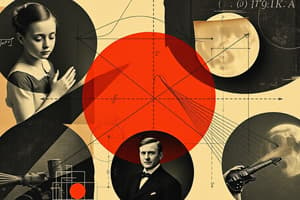Podcast
Questions and Answers
What is the function f(x) = 3x?
What is the function f(x) = 3x?
- One-one but not onto (correct)
- One-one onto
- Many-one onto
- Neither one-one nor onto
In the given context, what does the function f represent?
In the given context, what does the function f represent?
- Roll number assigned to a student (correct)
- Code number assigned to a roll number
- Assignment of students to code numbers
- None of the above
What does g(b) = the code number assigned to the roll number b signify?
What does g(b) = the code number assigned to the roll number b signify?
- Roll number assigned to a student
- Code number assigned to a student (correct)
- Assignment of roll numbers to code numbers
- None of the above
How is the combination of functions f and g defined in this context?
How is the combination of functions f and g defined in this context?
What type of function is g : B → C in this scenario?
What type of function is g : B → C in this scenario?
Based on the definitions given, which statement is true about f : A → B?
Based on the definitions given, which statement is true about f : A → B?
What is the relation R defined in set A = {1, 2, 3, 4, 5, 6, 7}?
What is the relation R defined in set A = {1, 2, 3, 4, 5, 6, 7}?
Why is R considered an equivalence relation?
Why is R considered an equivalence relation?
Which elements in the subset {1, 3, 5, 7} are related according to the given relation?
Which elements in the subset {1, 3, 5, 7} are related according to the given relation?
Why are elements in the subset {1, 3, 5, 7} not related to any element in {2, 4, 6}?
Why are elements in the subset {1, 3, 5, 7} not related to any element in {2, 4, 6}?
How many subsets of elements exist in the relation R for the set A = {1, 2, 3, 4, 5, 6, 7}?
How many subsets of elements exist in the relation R for the set A = {1, 2, 3, 4, 5, 6, 7}?
Why does the relation R include pairs of numbers both being either odd or even?
Why does the relation R include pairs of numbers both being either odd or even?
What does gof (2) equal to in the given functions f and g?
What does gof (2) equal to in the given functions f and g?
If f(x) = cos x and g(x) = 3x^2, what is the value of fog (x)?
If f(x) = cos x and g(x) = 3x^2, what is the value of fog (x)?
In the functions given, what is the value of fog?
In the functions given, what is the value of fog?
Why is gof not equal to fog in the provided functions?
Why is gof not equal to fog in the provided functions?
What does gof (5) equal to in the given functions f and g?
What does gof (5) equal to in the given functions f and g?
If f(4) = 5 and g(5) = 7, what is the value of gof (4)?
If f(4) = 5 and g(5) = 7, what is the value of gof (4)?
What is the main feature of binary operations?
What is the main feature of binary operations?
Which of the following is NOT a fundamental operation mentioned in the text?
Which of the following is NOT a fundamental operation mentioned in the text?
What does 'binary' refer to in binary operations?
What does 'binary' refer to in binary operations?
What is the general definition of a binary operation on a set A?
What is the general definition of a binary operation on a set A?
How many numbers can be added or multiplied at a time in binary operations?
How many numbers can be added or multiplied at a time in binary operations?
Which of the following statements is true about binary operations?
Which of the following statements is true about binary operations?
What do we mean when we say that (a, b) ∈ R?
What do we mean when we say that (a, b) ∈ R?
Which of the following best describes what a universal relation is?
Which of the following best describes what a universal relation is?
What is an empty relation in a set A?
What is an empty relation in a set A?
How would you define a trivial relation?
How would you define a trivial relation?
In the context of relations, what does the notation R = {(a, b): a – b = 10} signify?
In the context of relations, what does the notation R = {(a, b): a – b = 10} signify?
Which term defines a universal relation?
Which term defines a universal relation?
Flashcards are hidden until you start studying



